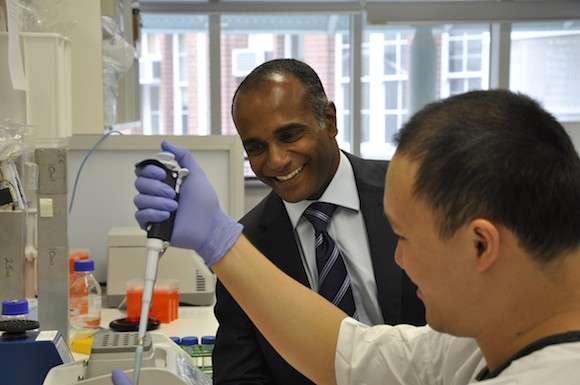Double discovery boosts global quest for leukaemia cures

Researchers at Peter MacCallum Cancer Centre have discovered how a form of leukaemia fights back against a ground-breaking treatment, providing vital new leads on how to outwit the deadly disease.
Acute Myeloid Leukaemia (AML) stem cells are particularly aggressive, insidious and nimble. Knowing how they respond when under attack enables researchers to devise interventions that can neutralise the source of resistance before it develops.
As part of the research - and for the first time - Peter Mac's Cancer Epigenetics Laboratory team has been able to grow and maintain leukaemia stem cells in a laboratory dish, making it easier and faster to test new treatments with the potential to eradicate the disease.
Published overnight in the premier scientific journal Nature, the research shows how leukaemia stem cells react to BET-inhibitors – a novel treatment which is the subject of a current international clinical trial active at Peter Mac. This promising treatment targets epigenetic mechanisms of disease to effectively "turn-off" cancerous genes in AML.
The research found that resistance develops when the cells adapt, increasing expression of proteins in the WNT/β-catenin pathway to circumvent the drug and reactivate key cancer driving genes through a previously under-recognised mechanism.
The double discovery will boost understanding of AML, which affects more than 900 Australians each year, and 300,000 globally, with five-year survival rates of just 25% according to lead investigator, University of Melbourne Associate Professor Mark Dawson
"Our clinical trial of BET-inhibitors is giving new hope to selected patients with aggressive forms of AML. However, the risk of resistance developing is common in any cancer treatment. Knowing precisely how that happens in advance puts us one step ahead in outmaneuvering the disease," A/Prof Dawson said.
"Being able to grow and maintain leukaemia stem cells in vitro, also gives us unprecedented access and insight into how they work, so we can find new and better ways to target and destroy them."
The findings build on over ten years of research and clinical work, commenced at the University of Cambridge by Associate Professor Dawson, who is now a consultant haematologist and head of the Cancer Epigenetics Laboratory at Peter Mac.
In 2011, Associate Professor Dawson and the team in Cambridge were instrumental in the initial development of this class of epigenetic drugs called BET bromodomain inhibitors. These drugs alter the way DNA is packaged and deciphered ultimately resulting in the "switching off" of cancer causing genes.
This therapeutic strategy is very effective in pre-clinical models of aggressive leukaemias and now Associate Professor Dawson is leading a first-in-class international clinical trial of these drugs in Australia, with the goal of increasing survival rates and advancing cures for aggressive blood cancers over the longer term.
Victorian Minister for Health Jill Hennessy said this is just one example of the world-leading research being undertaken at Peter Mac.
"We have some of the world's best researchers and clinicians here in Victoria and at Peter Mac, who are making advances in cancer research which could change the lives and outcomes of cancer patients."
The Leukaemia Foundation is a major supporter of the lab's work at Peter Mac. Head of Research & Advocacy, Dr Anna Williamson says it is exciting to see the Foundation's support for talented researchers with great ideas delivering important new knowledge.
"This advance in our understanding of leukaemia stems cells is opening the doors to new treatment approaches. "AML is a leukaemia that has long needed a major breakthrough to improve the future for all AML patients."
Acute myeloid leukaemia (AML)
Acute myeloid leukaemia (AML) is a type of cancer that affects the blood and bone marrow. AML is characterised by an overproduction of immature white blood cells, called myeloblasts or leukaemic blasts. These cells crowd the bone marrow, preventing it from making normal blood cells. They can also spill out into the blood stream and circulate around the body. Due to their immaturity, they are unable to function properly to prevent or fight infection. Inadequate numbers of red cells and platelets being made by the marrow cause anaemia, and easy bleeding and/or bruising. Acute myeloid leukaemia is sometimes called acute myelocytic, myelogenous or granulocytic leukaemia. AML is a devastating disease that affects 900 Australians each year, and 300,000 globally. Five-year survival rates are just 25%.
More information: BET inhibitor resistance emerges from leukaemia stem cells, Nature, DOI: 10.1038/nature14888


















